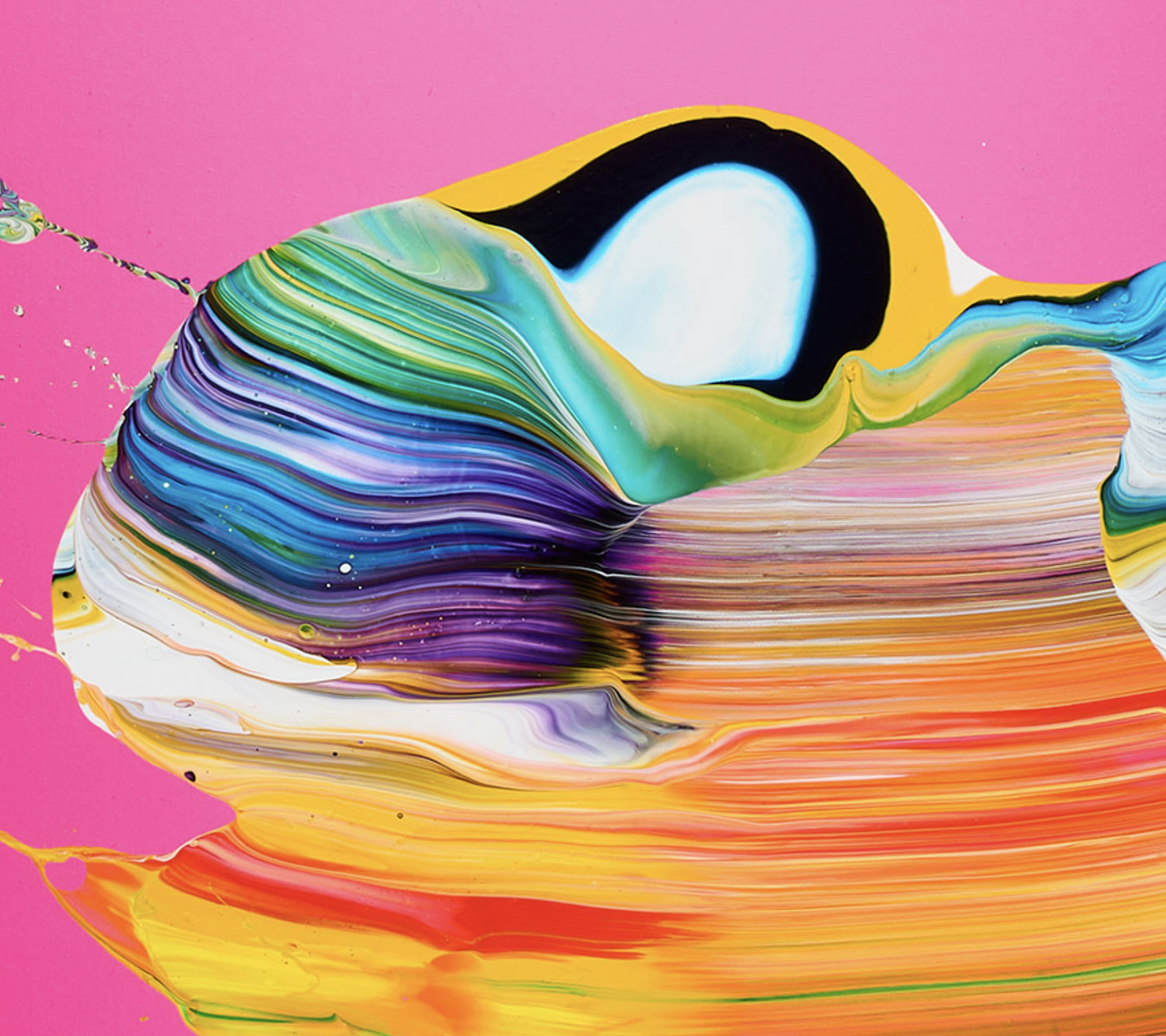Yago Hortal
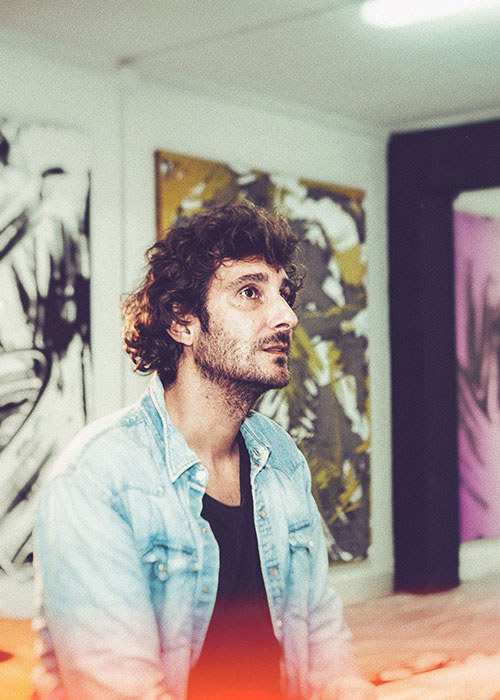
WORDS AND INTERVIEW BY CARLOS ÁLVAREZ PHOTOGRAPHY BY MANUEL NAVARRO PAGE 52.53 HBK1 PAGE 57 SP118 PAGE 58 SP159 PAGE 60 Z38 PAGE 61 Z25 PAGE 63 SP253 PAGE 64 HBK11PAGE 70.71 SP226 STARRING @YAGO_HORTAL WWW.YAGOHORTAL.COM BARCELONA SPAIN
There are many cities with an industrial area that speaks of its past and that, due to its own evolution, has been leaving behind that activity to give way to new uses. When we talk about artists and their studios, we all think of studios located in industrial buildings and it is there, in one such industrial building in Barcelona, where Yago Hortal opens the doors of his studio.
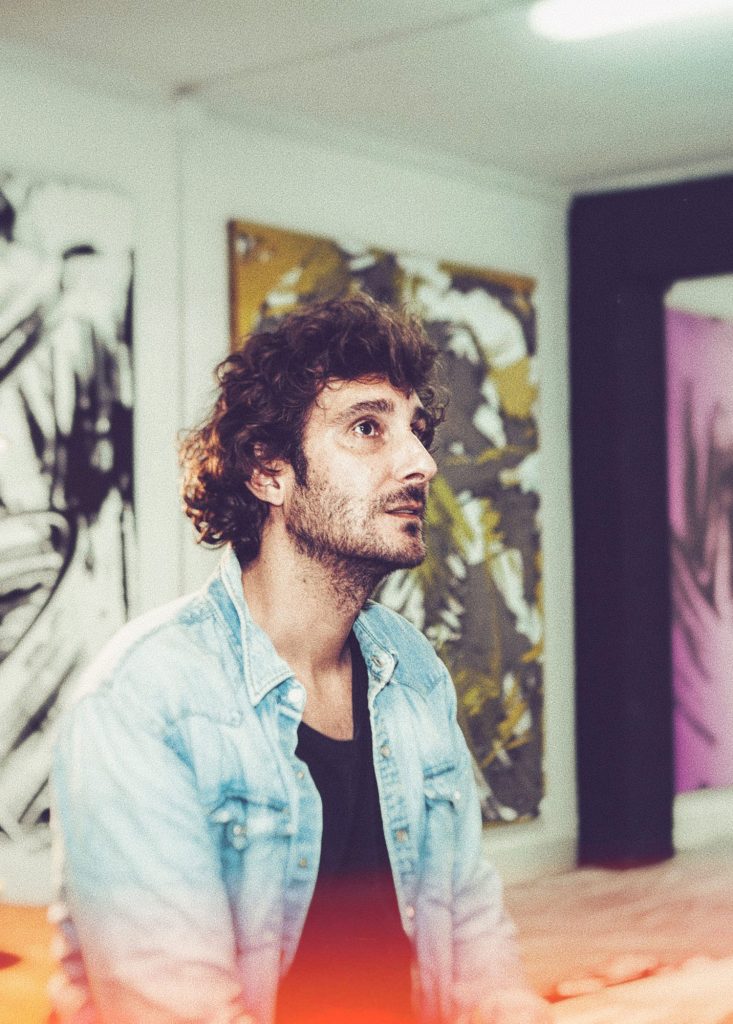
He confesses that he doesn’t usually open his studio to many people as for him it’s a very intimate space. As soon as you enter, you understand that all of his creative potential is cultivated here, away from the gaze of outsiders. Large canvases hang on the walls showing his latest works and a plastic carpet covers the area where Yago works, collecting everything that his canvases don’t want, in the purest action painting style.
A restless artist, but relaxed in his manner, he talks to us about his beginnings, the projects he is working on, such as the collaboration with an architect and the publication of a book, while he works on his next exhibitions. From the sofa, where we chat with Yago, you realise that his studio invites you to feel at home and his bed reveals that he often sleeps here after a day’s work. After having lived in different cities with his own studio, he’s not against the idea of moving again and it seems that he has a clear idea of where his next destination would be. And between daiquiris and Rosalía’s songs, he confesses that if Michelle Obama commissioned him, he would even paint a dress for her, although that has an origin that he prefers to forget.
Let’s start by talking about colour, if you like. Your work is a chromatic explosion. Tell us about colour and, if you have a colour that you always resort to more obsessively than others, what is it?
To answer this I have to go back to my childhood, to my earliest memories, my parents also point to it as the colour I was crazy about as a child, and it is the colour yellow. It’s true that it has stuck with me, if you look at my work, I paint a lot of yellow pictures. There is something in its visual power, its brightness in the retina that calls to me, but then to wear it as a colour, that is more difficult for me, even if I use it.
They say that wearing yellow on stage is bad luck.
That doesn’t affect me, those adjectives or looks that are given to colours shouldn’t exist, as happens with the colour pink, it is always labelled as a feminine and kitsch colour, and I don’t agree with that, I work with pink a lot, I don’t like to condition myself in that sense. Fluor is also a tone that is very present in a large part of my work and a couple of years ago, partly because of its association with urban art or kitsch, although now I’ve brought it back. Because in a certain way, they are colours that are in my nature, but I wanted to see what would happen if I worked with other types of tones. It happened to me with black, until a couple of years ago, I had never worked with black and I wanted to see how my work was evolving and what would happen if I eliminated all that seemingly superficial colour from my previous work. But going back to the meaning that colour has for me, it is pure nature, it is everything and everyone works with what they feel most in tune with at any given moment.
Then it’s true that when I’m preparing a specific exhibition, I pay a lot of attention to how they interfere with each other (paintings) when it comes to assembling them, if there is a red, I usually like there to be a green too, and I try to ensure that they can be close together or that they work together visually so that they contrast. And I always make these kinds of relationships with colour. Before, it was much more spontaneous. Now I think I do plan it more. I want a red painting or I want a yellow painting. Probably by forcing on the one hand, I’ve been forcing myself to remove as well. I specify more what I want now, as much as I can, because my work is really very spontaneous. It’s difficult to get what I want.
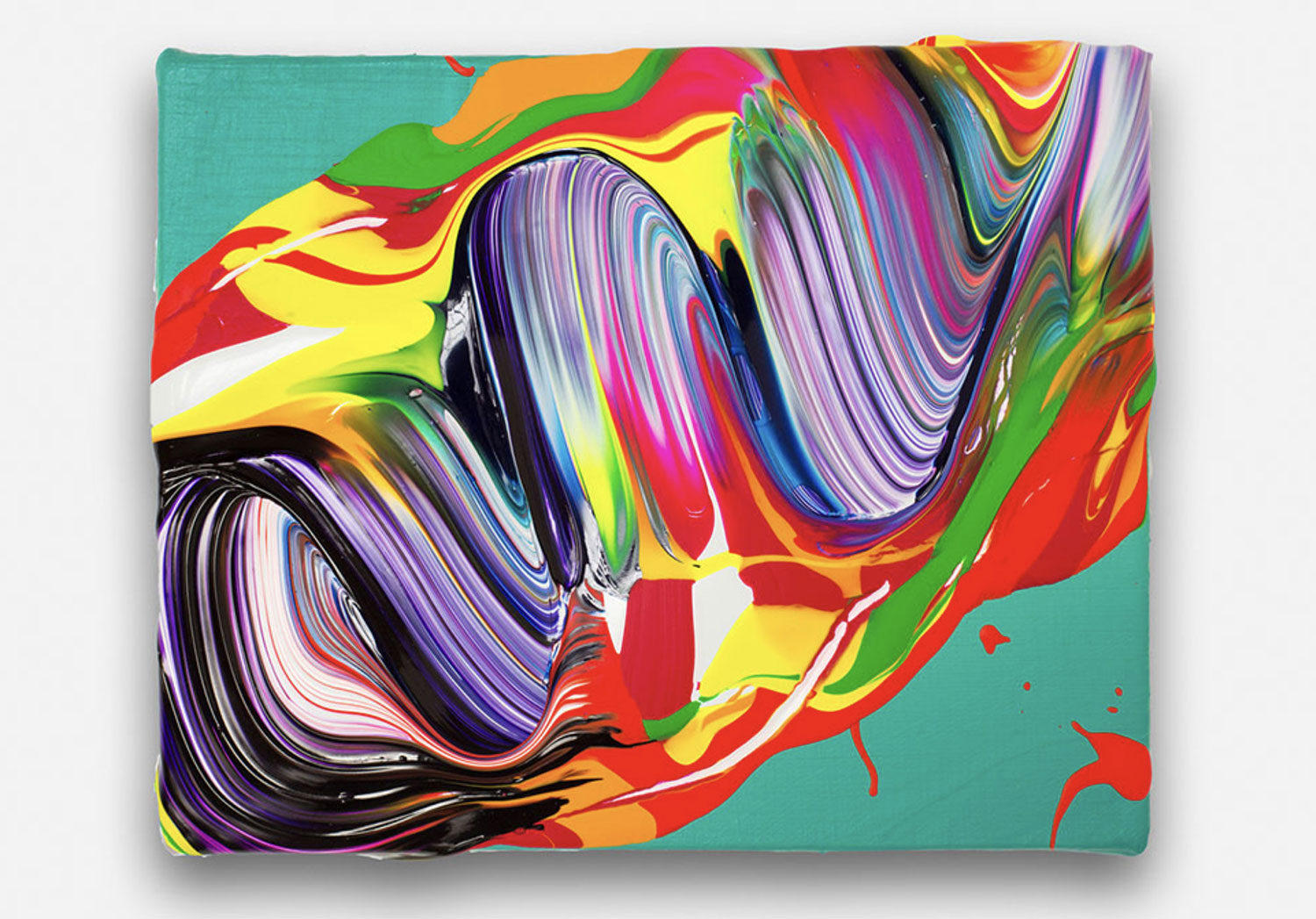
Let’s go back to black, as you were saying, it wasn’t a colour that you used particularly in your work until a couple of years ago, and we see pieces like SP246 or SP253, almost 100% black, or your latest works, where black plays a clear role in the work. Tell us about the colour black. What does it generate in you?
I had always rejected it, because I found dark tones in violets, blues, greens, turquoises, I didn’t need it. But as a result of the retrospective that I am carrying out together with the curator Enrique Juncosa at the Can Framis Museum of the Vila Casas Foundation (2021), I exhibited, for the first time, work that I had been creating for some time in the studio, something I wasn’t showing, so when I finished that exhibition, I decided to work with that new intention for the two exhibitions I had in September at Galería Senda in Barcelona and Galerie Nikolaus Ruzicska in Salzburg. It was to work with the colour black without artifice, without really provoking a blow to the eye with the colour, but on the contrary, to strip myself of that chromatic explosion, to stay a little bit with the bones of my paintings. I had started to use more natural tones, graphite tones, charcoal blacks, earth tones and that sort of thing, perhaps going back to things I had done as a student and that perhaps I hadn’t paid attention to, they were a way of returning to using those natural tones that took away a little of the superficiality of what my previous painting might have seemed to have had.
The titles of your works look like elements of the periodic table numbered consecutively. Is there any meaning to it or is it a way of cataloguing them so as not to condition the spectator with a title?
I would say that both things work for me as a catalogue, because when I start to work with galleries, I realise that it’s chaos that all my pieces are “untitled”, “untitled”, “untitled”. Like for example Luis Gordillo or Juan Uslé, both of them need a specific title for the work to be finished. I don’t, because I think the title confuses, if you don’t find the right one, it conditions too much already. And my way was to take the initials of the studios where I was working. Now the Z stands for Zamora street because I moved a couple of years ago and I’ve already started with Las Zetas, the SP of Sant Pere Més Alt, and so the K’s stand for Berlin, Kunstfabirk, Kulmerstrasse HBK is the Hall Street studio in Brooklyn and all that because it was a way of ordering and working by periods, by seasons and having a register.
You studied art at the universities of Barcelona and Seville and in the initial years of your career, you were defined as one of the most internationally renowned new artists. What was it like for you to be given that label, did it stimulate you or did it put pressure on you to create work?
Both things, on the one hand it stimulates you a lot, because it’s quite complicated to move in this world and it’s flattering that galleries notice you from the beginning and say that kind of thing, it’s nice and wonderful, but at the same time it puts pressure on you, because you’re not ready yet, you don’t really know what you’re doing, even if you have a lot of impetus and desire, you’re still very green, but you try to do the best you can. It still happens to me today, because sometimes you know that people talk about you, but then you see yourself in a different way, you process it inside you in a different way and that depends on the character of each artist, but sometimes it does create pressure. There is an expectation that you have to fulfil, although the basic thing is to fulfil it with yourself, to be honest with what you do and what you feel.
Your work has a very powerful language. I read that at the University of Seville you worked more figuratively, but I don’t know if it was only during your studies or if you continued exploring that language. How did you come to define your own language?
That stage was very early on, in the third year of my degree. I suppose that, like many artists, you start with something, in my case it was portraits, I was very interested in skin, wrinkles, especially portraits of old people, where their skin tells us about the passage of time and to be able to represent reality as faithfully as possible. But at the University of Seville, the most academic faculty of fine arts in Spain, It was there that I was awakened to a rejection of the way they were teaching art at that time and a very interesting group of people was created who didn’t think like the majority of the teachers. We also needed to paint more hours than we were allowed and we had to make a living outside the faculty. That’s when I began to see other things in painting that had already come with me from Barcelona. I remember a discussion with the best teacher and friend, Pep Montoya., who unfortunately died of COVID, and he told me this: focus, paint figurative or abstract, if that’s what you want, but do what stimulates you. And although it all sounds very banal, and I didn’t understand it at the time, it is true that his comment echoed in my head during my stay in Seville. When we met again in Barcelona I had already discovered certain things that led me to find my language.
And I don’t know if it’s right, but in my case I think it was, and that is to make this kind of change. For example, what I was saying before, when something is expected of me, after having a very long career, and a very personal and representative work with a very established name, I somehow got shaken up and decided to do something else. But people still have the previous 15 years of me.
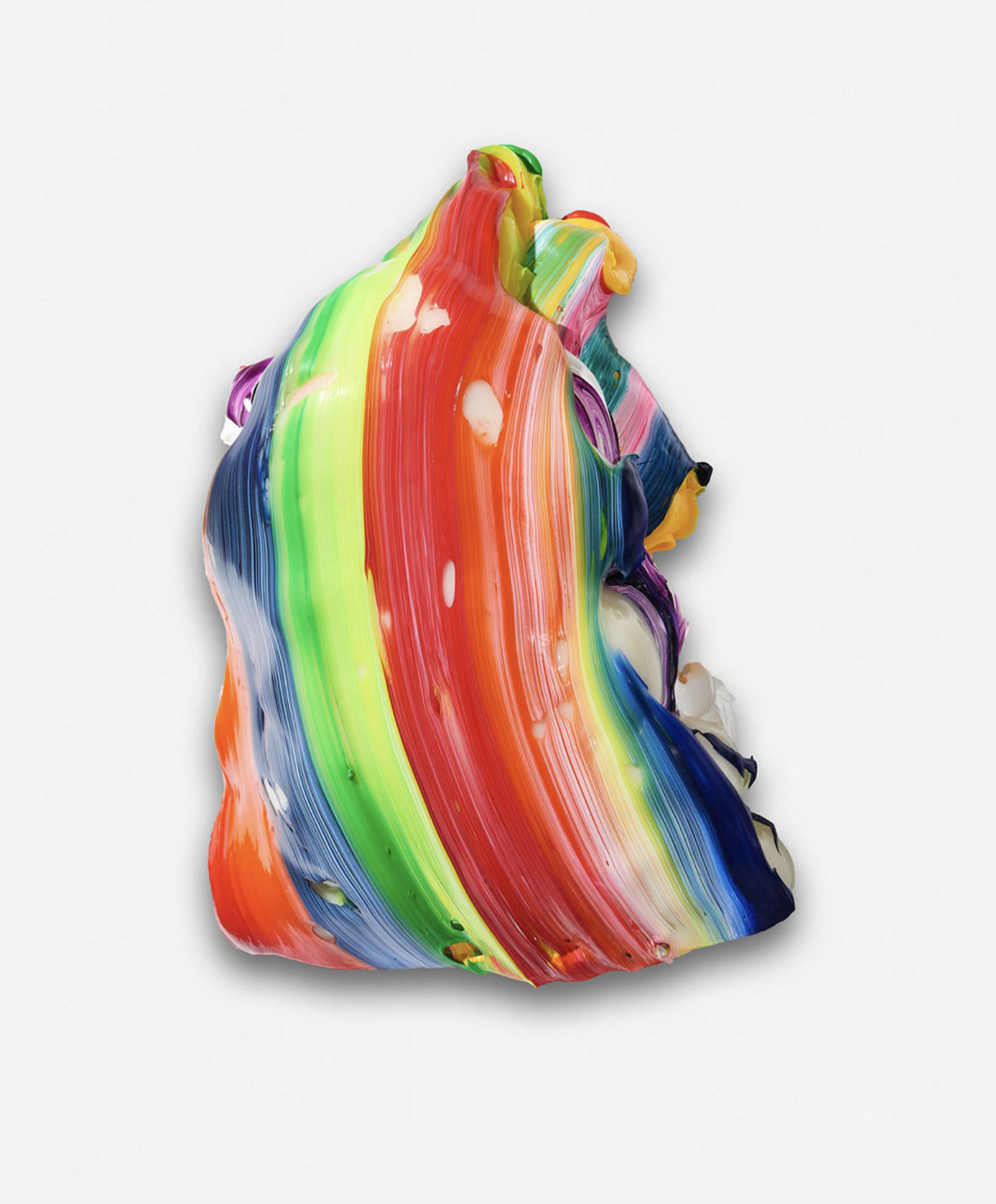
Well, they are very iconic pieces.
Yes, and that’s good, because you’re supposed to have achieved something and I don’t rule out going back and mixing things up, but right now I’m much more interested in the things I’m doing now, which is basically the same interest I had when I was doing the other stuff.
When it comes to work, what time of the day do you feel more productive, at night or during the day?
I’m quite nocturnal. So for a while now, I’ve been forcing myself to change that habit, although there are days when it works better than others. But generally speaking, I’m very nocturnal because I have a different peace. It’s a time when I don’t have to take calls or answer emails, I’m alone with my things, my paintings and I work more at ease. But lately, at eight o’clock I’m up, at nine o’clock I’m working and if the day has gone well, then at 8 or 9 p.m. I’m done for the day. But it goes in spurts. There are also times when I work a lot of hours, I sleep badly, the next day I work the same hours, but then I take a day off, because sometimes my head just can’t take it anymore and I need some air.
A perfect day out of the studio?
Honestly? Hahaha, who was that the other day? I found it really funny. I think it was the Matrix actor, what’s his name? Keanu Reeves, yeah! I saw a story of his on Instagram that said: A perfect day? Get up without rushing, have good sex. Have a good breakfast, have good sex. A good shower, go to the beach, have a good meal, have good sex, take a nap, have a drink with friends, have…
Sex all the time!
I was very amused to see him responding so spontaneously, but it could be more or less something like that. To be at peace, to leave unfinished business aside, to enjoy simple pleasures, to be with your loved ones and always with good meal. For example, a few days ago I went to see the exhibition of Lolo and Sosaku and I so stoked, we went with some friends, because Victor Jaenada together with other artist and curator friends were organising a popular action/exhibition/food in Hospitalet, and we went to the vermouth session, then the meal, then the exhibition and all this in the company of good friends with no aim other than to enjoy the day.
And when you’re on holiday, for example, do you consume art by going to museums, galleries or fairs or do you switch off completely and sip a daiquiri while the sun sets over an exotic skyline?
If it’s a real holiday, I prefer the daiquiri, I think, but it depends where you go, there will always be something interesting to see, but I need a lot of mental space and sometimes having a lot of artistic information confuses me, instead of inspiring me, which it also does, but seeing a lot of things often makes my head whirl. I always try to focus on the studio, on my own evolution. It’s the same with social media, because you see so much stuff and usually so much bad stuff, that it confuses you and creates a kind of addiction. But in general I don’t manage social media very well, it creates a certain kind of anxiety in me and it should be more natural, to post what you feel like, and I do the exact opposite, I’m very strict, I only post pictures that I like. So, a full holiday would be to see some good exhibitions and then switching off with some beautiful sunsets and that daiquiri.
What has the pandemic meant to you on a personal and creative level?
On a creative level I don’t attribute my change directly to the pandemic, but perhaps it does coincide with the change of studio and that is always a plus when you want to give your work a new twist. During the lockdown I kept my usual rhythm, the studio is below my house, so I could go without stepping onto the street and continue working in the same way, although with less materials because they couldn’t supply you. It is true that there were some days when I voluntarily stopped working because I needed that time of reflection in which we all stop for a while to think about where you are and where you want to go, taking importance away from many things and giving it to the things that really matter. We lived through times when we didn’t know what was going to happen, that’s scary and I didn’t really care if I painted or not, among other things, I wanted my parents to be okay.


Do you share the opinion that in times of crisis art becomes more valuable?
In this case, the effect of the pandemic on the art world and above all the galleries, was that it forced them to operate differently, as they no longer had the physical spaces and the art market couldn’t be stopped. In the end, it’s a market where people invest their money thinking that art rises in value, and that led to a market renewal. However, it also slowed down a little, there were many collectors or customers who were suddenly afraid to continue investing, because they didn’t know if the world was going to end. Fortunately for everyone, it turned out well.
I guess you have countless references in the art world, from the most clichéd to the most unknown. Tell us about one that has marked a “before” and “after” in your work.
There are many but I always remember Howard Hodgkin’s exhibition at the Reina Sofia, I went round and round, I went in and out, I explored it upside down and inside out, while the security guards looked at me with very strange looks on their faces. I was very upset, there were some very powerful paintings that moved me, and that doesn’t happen to me very often with painting. Sometimes you look at techniques or tricks that you want to discover, but that man really moved me inside and I would say that that was the strongest, because it’s the one I remember most as a before and after. Also, they are paintings that look like they were done really fast, in a very expressionistic way, very spontaneous, and the truth is that it took years. Another that caused me a similar sensation was a visit to the José Guerrero Art Centre in Granada. He is one of my favourite artists. And more closely, I had a revelation watching friends like Rorro Berjano, Víctor Jaenada, Alan Sastre or Pedro Paricio painting while we were studying together. the way they approached the works made me say to myself, “you’re doing well, but you haven’t yet reached that point of what your art has to be”. Others I have always liked very much are Robert Motherwell, Katharina Grosse, Bernard Frieze or Miguel Angel Campano, to name a few.
In 2016, you were given the chance to do a four- handed exhibition with Peter Halley, and I believe you didn’t meet until a few days before the opening, what was it like preparing the exhibition at a distance?
Peter Halley is a wonderful person, a few days ago I met him again, in his studio in New York and apart from being a “big name”, he’s a lovely guy. I really liked the way he treated me; a young artist, he, an established artist, and working together. In addition to the 3 works by each of us that were in dialogue in the exhibition, we worked on 5 works together. He valued my proposals very much. They were a series of works that we worked on digitally, because there was no other way and it was all about sending each other proposals, each one stepping on the other’s toes, at a complementary level. At the beginning, I was very respectful, but he always treated me as a close friend. We made 2 pieces with my base, which he would then distort, and the final image was always his, and another 3 the other way round. I learnt a lot from him about how to handle the studio, how to approach an exhibition in a different way to the way I was doing it, it was a great experience.
Have you shared a studio with other artists? If so, what was the experience like?
When I left the faculty, at the beginning I shared a studio with a friend in Poble Sec, but then I was awarded the prize for young painters and at the same time I started working with the Senda Gallery, and they offered me a house in Vallcarca, through a collector friend of the Gallery, which I always say was a house of ghosts, because it was a modernist mansion, which was half boarded up and had been a university residence, where there were still the bunk beds, photos and litrons of the former students on the first and first floor. They offered it to me as a studio, and I accepted eagerly. One day the police wanted to throw me out because they thought I was a squatter, it was crazy, finally they saw that I was related to the owner and there was no problem. I was there for 2 or 3 years and it was amazing, because suddenly I had 500 metres of destroyed house, although without the trace of the students, but it was 500 metres, plus its 500 metres of garden with fruit trees and fountain included. It was a creative explosion, that’s when I started to produce like I had never produced before. Before that I spent a time in Portugal and then I spent some time in Berlin, New York and always with my own studio.

Where would you live if you had to move to another city tomorrow?
Well, Mexico, Mexico City, is calling me. I have several friends who are living there and they’re always telling me come on, you’re missing out! I had always thought about New York, where I spent three months working, and I spent three years in Berlin, which I loved, Los Angeles is another city that calls me a lot, I’ve been there a couple of times, but I haven’t had a workshop there. But Mexico is really coming on strong and I don’t know, I think I’ll try it this year, with the excuse of going to the ZonaMaco fair, and see what vibe I get.
Let’s talk about something that has probably been the most unpleasant episode in your career as an artist, which is the legal battle you fought with an English clothing company over plagiarism. And to add a touch of humour, we could say that, without your permission, they dressed people as admired as Michelle Obama or Jessica Biel with your work. Tell us what that experience was like and if you can share any amusing anecdotes.
Well, you have to look at it lightheartedly. But the truth is that it was brutal. I found out through a good friend who lives in London and who, on the underground, saw in a newspaper a photo of Niguella Lawson, who is Charles Saatchi’s ex-wife, wearing a dress that was basically my paintings …. My friend knew my work very well, so he called me to tell me about it.. I decided to talk to my lawyer, and it should have been relatively easy, because normally these types of companies have a sum of money set aside for this kind of issue. As it turned out, it was not. They denied it from the beginning and because they are such big companies, they think that you won’t find out and if you do, they think that because you’re a young artist, they won’t be sued, because if they are sued, they have the financial capacity to crush you. But my case was obvious and I initiated the lawsuit, through my lawyer, together with his English counterpart, because the case is prosecuted in the country where the crime is committed, if you want to sue at the international level. It was almost 3 years and they only started to take me seriously when they saw that I wasn’t going to give up. Fortunately, I could afford to pay the costs of all the proceedings, which were high, especially in England.
At one point, the case came out in the press and was published in the Financial Times and The Art Newspaper. began to accuse me of defaming them. At the beginning, all of these things are scary, but if you are convinced that you are right, let them sue you, they have nothing on you. Finally, a few days before the trial, they made me an offer, which we rejected outright, and with the second offer they made, we reached an agreement. That’s how it was settled. But it’s exhausting and you never know if they comply with what was required of them, such as the destruction of the garments…
Have you done anything artistic outside of canvas, such as murals or even for the fashion world? Under your direction, of course.
Well, I have always been contacted by brands from all sectors to propose collaborations, but there was a time when I received daily proposals from the leading brands of clothing, make-up, cars, furniture, pianos, food, alcohol, snowboards, underwear, cinema, theatre, department stores… But I have always been very careful with this kind of collaborations because I didn’t want to burn my image and confuse my artistic career, so that my work wouldn’t be taken seriously. In a collaboration with Smashbox we recorded a video where I showed a technique I was doing and now there are 300 people on the networks doing the same thing I was doing then… But now I’m working with an architectural firm on a very stimulating project. We are looking at how to plan a façade, but not in a muralist way but with other types of materials and we will see what happens, it would be exciting, but it is difficult for me, for the moment my thing is painting on canvas.








You have works that are three-dimensional, where the layers overlap, giving a lot of life and volume to the piece. Do you see them as paintings or as sculptures? Have you ever considered making a sculpture?
For me they are paintings that are a little bit closer to sculptures, but they are still paintings because they are still on the wall. I have sculptural ideas, what happens is that my own work absorbs me. So I don’t dedicate time to developing the other part and it’s still there, latent. But I have ideas in my head that one day I would like to materialise, but I have to focus on the whole process and come out of my work with the canvas.
Have you been commissioned by famous people? What has your relationship been like?
I’ve met some pretty famous people, but the truth is that I don’t work on commission. Sometimes when I’ve wanted to take a commission, I haven’t been satisfied because it doesn’t work out well, to be honest. And that’s because the person that commissions something has a preconceived idea of a painting, which maybe they have already seen, and even if they give you guidelines, and I don’t like to be given guidelines, but I accept them, then what theotherpersonhasintheirheaddoesn’thappen and it’s strange. You stop all the work you are doing to dedicate yourself to that and then it doesn’t always come out as you expect, so I try not to take any commissions, because the truth is that right now it doesn’t make much sense. Sometimes it’s stupid, because I lose money, but I prefer not to take the assignment, it’s not my modus operandi. Maybe if someone came along like the Obamas, I would say yes. I would paint him a painting or I would paint Michelle a dress, but that hasn’t happened so far hahaha.
A Playlist for work?
Well, I listen to a lot of hip hop, I’ve always had a very strong American influence from hip hop in the 90s. And then I like a lot of jazz, flamenco, electronic music, in Berlin it hit me very hard, it’s been working lately as well. Music all of the time! I’ve just been in Puerto Rico and I understood reggaeton, I thought it would never happen to me and being there, you get into the sounds and now I enjoy it, though not all of it. But the artist that I love is Rosalía, right from the start, I think she’s a great artist. And apart from music, I also listen to a lot of podcasts while I work, interviews of interesting people or topics that interest me at the time, it’s a great format, a new way of doing radio that I find very interesting.
Chess or Ludo?
I would say chess to look good, it’s classier hahaha, but I haven’t played for a long time and I think I’d be better at Ludo, although I don’t remember the rules very well either… but, just for the colours, I’ll take it.
